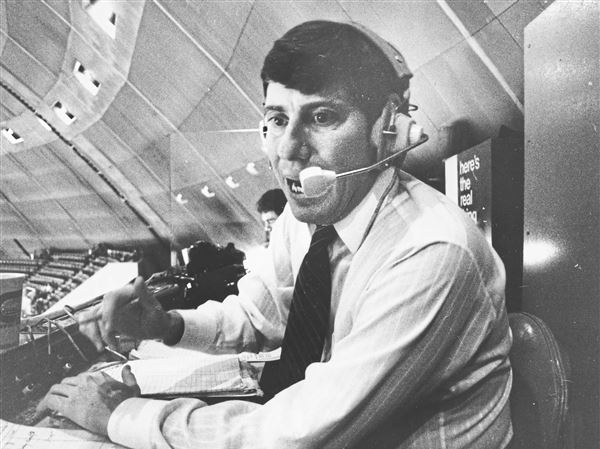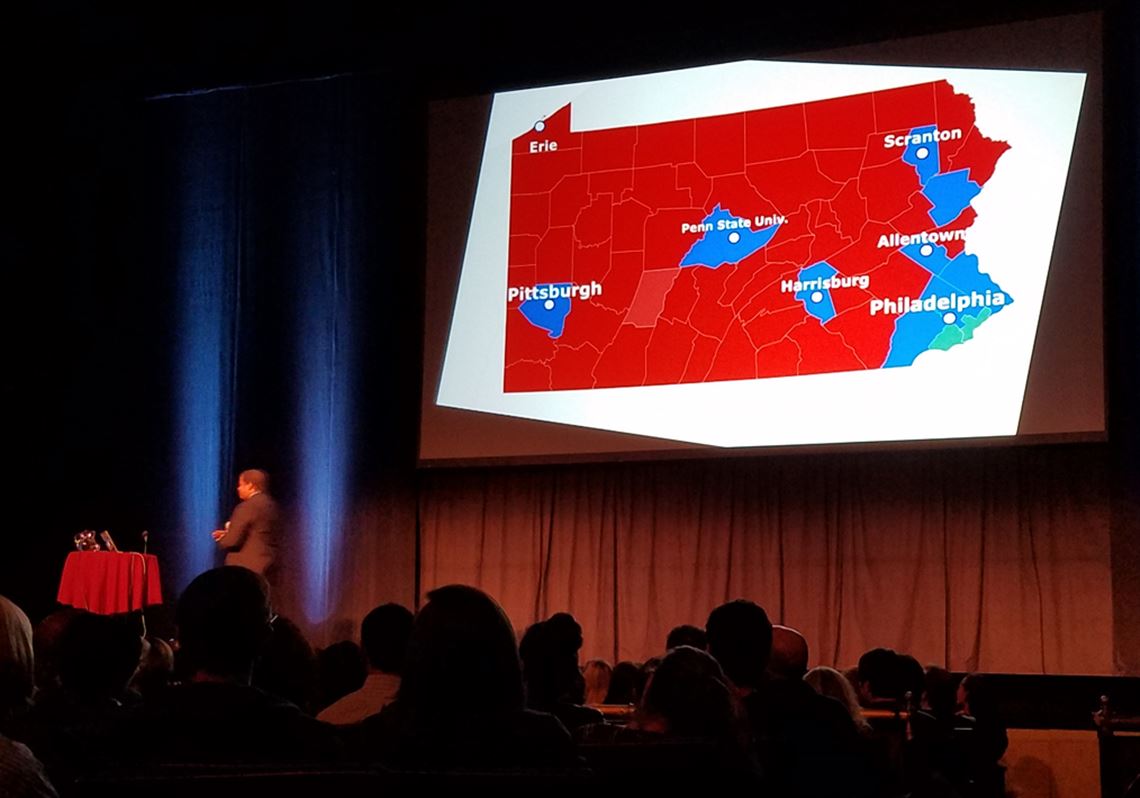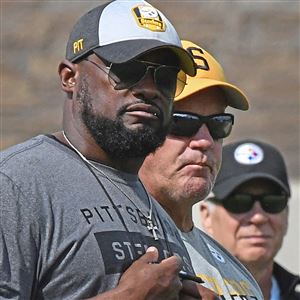Popular astrophysicist Neil deGrasse Tyson was in Philadelphia Wednesday night to talk about the bad science that litters most motion pictures.
But in the wake of the election of Donald Trump, who has called climate change a hoax made up by the Chinese and been dubbed "the first anti-science president,” it’s not surprising Mr. Tyson’s speech veered from the silver screen into the world of politics.
In fact, Mr. Tyson opened the show with a jab about Pennsylvania’s role in electing Trump president. After giving a performance in Pittsburgh on Tuesday, Mr. Tyson went to Google to find a map of Pennsylvania to help him navigate the long drive to Philadelphia, but instead was served a map that breaks down how counties voted during the election. He joked Google was warning him there was a lot of red between the two cities where people wouldn’t necessarily appreciate the objective facts he was offering.
“Notice the blue areas on the map are all urban and science friendly,” Mr. Tyson noted, pointing out Allentown, Scranton and Harrisburg also reside in blue counties. “The only other blue area on the map happens to be a institute of higher learning.”
Mr. Tyson was in Florida on the day of election, and as it became clear the Sunshine State was going to go to Mr. Trump, the astrophysicist had strong words for voters in the state.
“Half the state is four millimeters below sea level,” Mr. Tyson warned those in the state who voted for Mr. Trump. “You start melting ice caps, and Florida is going to be the first state to go.”
When Canada came up, Mr. Tyson pointed out that the country’s population is heavily concentrated near the border with the U.S., “as if they’re planning on invading.”
“Not anymore,” an audience member yelled, alluding to the election of Mr. Trump as president.
“Yes, you’re right. In fact, they just built a wall along their border,” a laughing Mr. Tyson responded.
Mr. Tyson also sharply criticized former Republican presidential candidate Ben Carson, who Mr. Trump is reportedly close to appointing to his cabinet as the country’s secretary of Housing and Urban Development. Among other things, Carson has called the big bang theory a “fairy tale” and claims the theory of evolution was encouraged by the devil.
“One person’s personal truth should never be legislated over other people’s personal truths,” Mr. Tyson said, noting that it’s best to leave science to the scientists. “Objective truths always remains true whether or not you believe in them.”
Despite the deep dive into politics, Tyson managed to dissect the bad science in a number of popular films, some of which are revered by fans due to their serious approach to science.
Take Steven Spielberg’s 1977 film Close Encounters of the Third Kind. In the film, humans know where the aliens are planning to land because they are sent coordinates through a computer. But as Mr. Tyson points out, latitude and longitude are arbitrary human inventions, which means the aliens had to have spent a lot of time learning about humans and their culture to convey that information.
“If they already knew that much about our culture, then why didn’t they just learn English and tell us where they were landing?” Mr. Tyson asked rhetorically.
Mr. Tyson had a series of small but pointed gripes about bad science being deployed in the number of films. He joked about asteroids that appeared to have GPS units set for Manhattan landmarks in Armageddon and corrected Jodi Foster’s math about the abundance of life in the universe in Contact. He pointed out that robots keeping humans alive in The Matrix so they could be used as batteries breaks the second law of thermodynamics. And he reminded the audience of his 10-year beef with James Cameron over the use of the wrong star-filled sky in The Titanic, which was remedied during the film’s rerelease.
But for all the films he nitpicked with his trademark combination of intelligence and humor, he was quick to praise a number of movies that, against all odds, managed to get the science correct. And some of those moves were completely unexpected.
He praised both A Bug’s Life and Star Trek VI: The Undiscovered Country for getting the science of surface tension right in their depiction of liquids. He lauded The Expendables 2 for mostly getting Albert Einstein’s equation for general relativity correct. And he heaped praise on Frozen for having Elsa sing about geometry.
“Ladies and gentlemen, this is an animated Disney character literally singing about fractals,” an impressed Mr. Tyson noted.
Nowhere was Mr. Tyson’s unique mix of intelligence and unabashed geekiness on display more than when he talked about the Marvel superhero Thor, or more specifically, the weight of his famed hammer, Mjolnir.
Mr. Tyson showed the audience a clip of Thor’s father Odin (played by Anthony Hopkins) revealing that Mjolnir was “forged in the heart of a dying star.” So Mr. Tyson quickly figured out the density of a neutron star and applied it to the size of Thor’s hammer, and calculated that it would weigh as much “as a herd of 300 billion elephants.”
But as Mr. Tyson pointed out, even his level of geekiness is no match for the internet. After tweeting out his calculations about Mjolnir, they were quickly taken to task by fellow scientist Suveen Mathaudhu, who claimed it’s well documented the hammer is made out of “Uru,” a fictional metal from Thor’s home of Asgard. He goes on to point out that a 1991 Marvel trading card notes Thor’s hammer weighs precisely 42.3 pounds.
“I concede to the sheer depth of his geekdom,” Mr. Tyson said with a devilish smile on his face. “But I still think 300 billion elephants is pretty good.”
During a Q&A following the lecture, the subject unexpectedly turned from his thoughts on movies and politics to his wardrobe.
“Why are you only wearing socks?” one eagle-eyed audience member yelled at Mr. Tyson, who was wearing his trademark galaxy-covered vest.
She was right. The crowd murmured as they all suddenly realized at once Mr. Tyson had done his entire two hour talk about the good and bad of science in movies without wearing shoes.
As it turns out, it was a conscious decision on Mr. Tyson’s part to perform his entire talk on the Academy of Music’s historic stage shoeless.
“This is not a lecture hall, it’s a performance space,” Mr. Tyson responded, noting the nearly 160-year-old stage has been home to some of the best opera, ballet and broadway performances of all time.
“I’m not a performer, I’m a scientist, so I’m just an interloper in this space,” Mr. Tyson continued. “It’s a sign of respect.”
Rob Tornoe: @RobTornoe
First Published: December 1, 2016, 8:31 p.m.
















